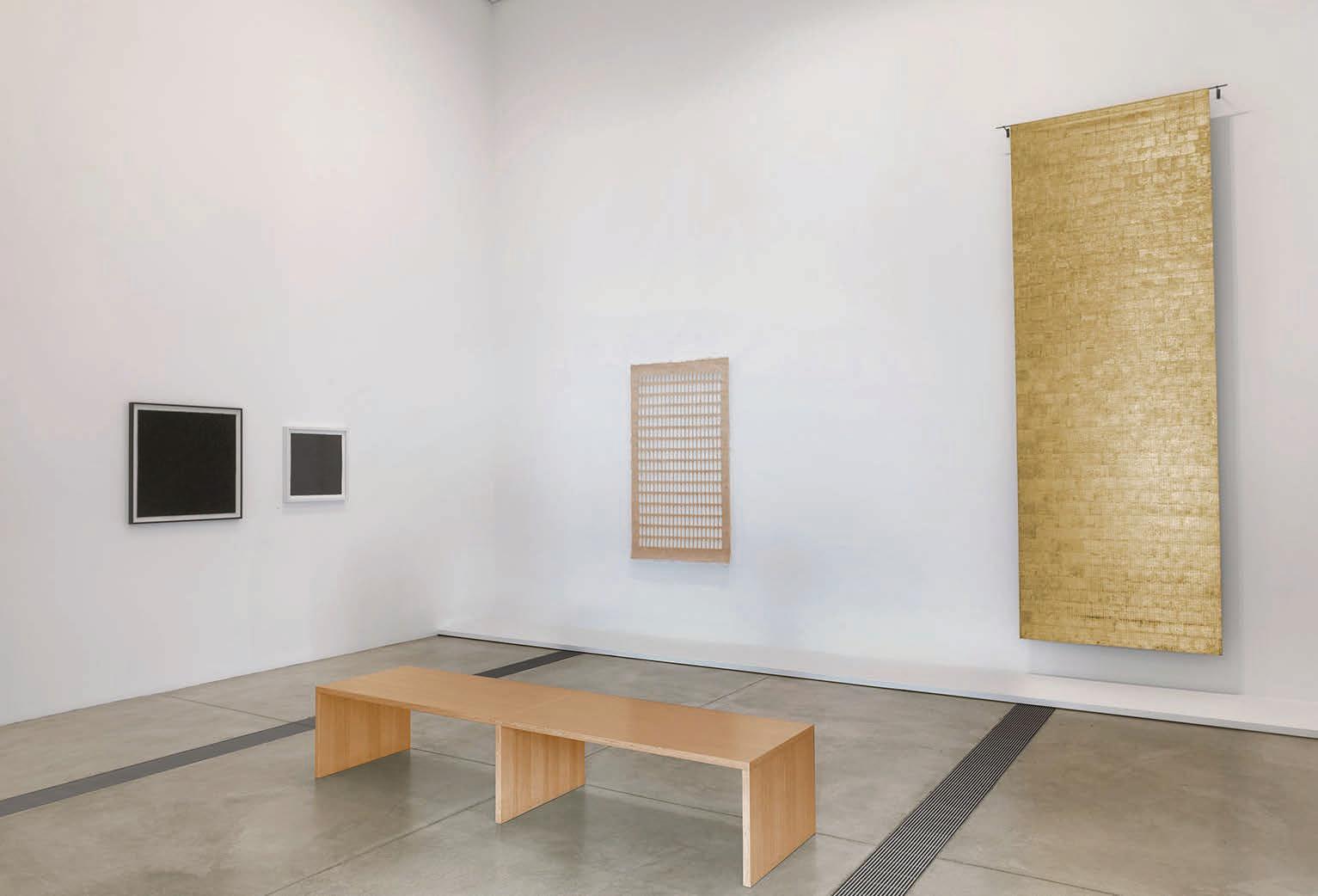
12 minute read
Exhibitions


Advertisement
Kunmanara (Mumu Mike) Williams, Pitjantjatjara language group. We Don’t Need a Map (Mapa Wiya), 2017. Ink and acrylic on found map, 23 1/4 × 35 1/2 in. (59 × 90 cm). © Kunmanara (Mumu Mike) Williams. Image courtesy of Fondation Opale, Lens, Switzerland
Mapa Wiya (Your Map’s Not Needed): Australian Aboriginal Art from the Fondation Opale September 13, 2019–February 2, 2020
Aboriginal and Torres Strait peoples are advised that this document mentions names of deceased people.
In the fall of 2019, the Menil presented Mapa Wiya (Your Map’s Not Needed): Australian Aboriginal Art from the Fondation Opale. Meaning “no map” in the Pitjantjatjara language of the Central Australian desert region, the exhibition title was drawn from a drawing by artist Kunmanara (Mumu Mike) Williams (1952–2019). His recuperation of official government maps and postal bags is a pointed response to the foreign cartographies of the country that Australian Aboriginal peoples embody. This exhibition marked the first showing of his work in an American art museum. Country is the foundation of the autonomous ways of the Aboriginal peoples. Vast deserts and rainforests with their distinctive rock formations and water holes, and other meaningful spaces, including the land on which cities have been built—these are the diverse terrains of their lives. They are places in which the laws and primordial creations of ancestors are always present, where painfully violent colonial histories are memorialized and potential futures are reclaimed in song and dance. Knowing the land, moving through it, and living with its deeply embedded song lines animate the rich visual expression of Aboriginal artists. Reflecting on the long history of art-making and different ways of Aboriginal peoples, Mapa Wiya highlighted work created after the 1950s and included more than one hundred contemporary painted canvases, shields, hollow log coffins (larrakitj or lorrkkon), and engraved mother of pearl ornaments (lonka lonka or riji) held by the Fondation Opale in Lens, Switzerland, one of the most significant collections of Aboriginal art. The exhibition showcased large, vibrant, and at times collaboratively painted works by internationally recognized artists such as Clifford Possum Tjapaltjarri (1932–2002), Paddy Nyunkuny Bedford (1922–2007), Emily Kame Kngwarreye (ca. 1910–1996), Gulumbu Yunupingu (1945–2012), John Mawurndjul (b. 1952), and Warlimpirrnga Tjapaltjarri (b. 1950). Mapa Wiya (Your Map’s Not Needed): Australian Aboriginal Art from the Fondation Opale was curated by Paul R. Davis, Curator of Collections.
Major funding for this exhibition was provided by The Anchorage Foundation of Texas; BHP; Olivia and Peter Farrell; and Melza and Ted Barr. Additional support came from United Airlines; Henrietta Alexander; Nana Booker and M. David Lowe; Clare Casademont and Michael Metz; Robert J. Kleberg Jr. and Helen C. Kleberg Foundation; Australian Consulate-General, Houston; Mark Wawro and Melanie Gray; Suzanne Deal Booth; Cindy and David Fitch; Linda and George Kelly; Adelaide de Menil; Susan and Francois de Menil; Franci Neely; James W. Stewart, Jr.; Taub Foundation/ Marcy Taub Wessel; and the City of Houston.

From left to right: Gauthier Chiarini, Director of the Fondation Opale; Georges Petitjean, Curator of Collection Bérengère Primat; Sally Scales of the APY Art Center Collective; Menil Curator of Collections Paul R. Davis; Artist Teresa Baker; Nathalie Bizart of Fondation Opale; Bérengère Primat, President of the Fondation Opale; and Menil Director Rebecca Rabinow at the Menil members opening on September 12, 2019. Photo: Jenny Antill
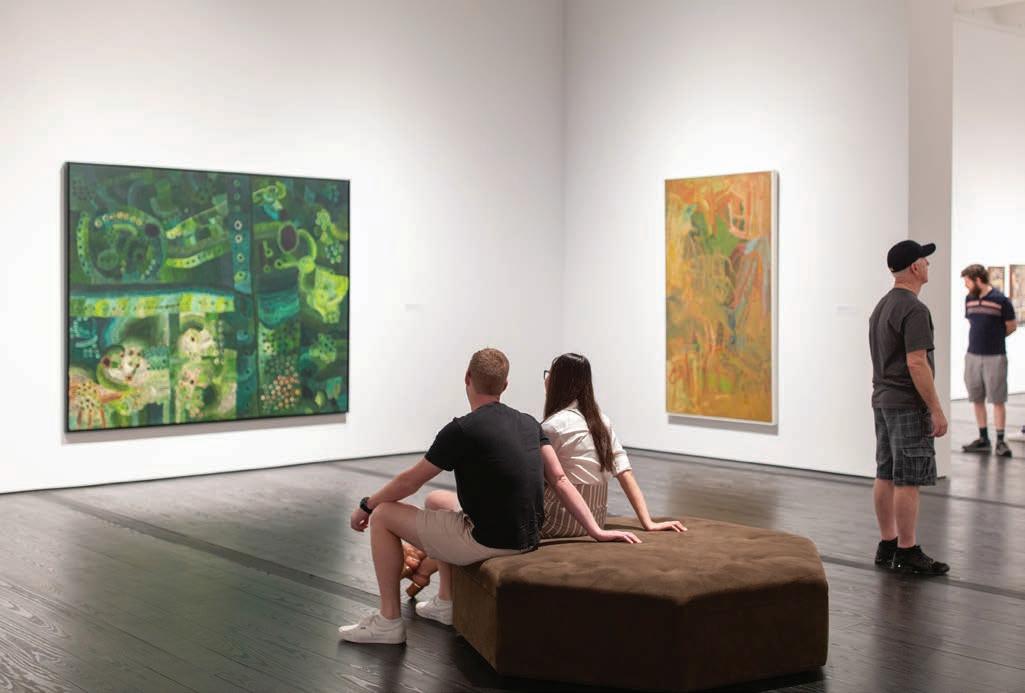
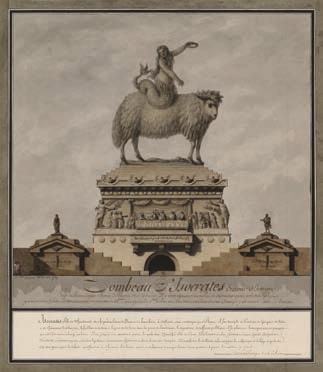
Jean-Jacques Lequeu, The Tomb of Isocrates, Athenian Orator (Tombeau d’Isocrate, orateur athénien), 1789. Ink on paper, 18 ½ × 16 ⅛ in. (46.9 × 40.9 cm). Collection of the Bibliothèque nationale de France
Jean-Jacques Lequeu: Visionary Architect, Drawings from the Bibliothèque nationale de France October 4, 2019–January 5, 2020
Draftsman and architect Jean-Jacques Lequeu (1757–1826) was one of the most inventive artists of post-revolutionary France. His spectacularly detailed drawings range from actual proposals submitted to government entities to fantastic and speculative structures intended for the page alone. Jean-Jacques Lequeu: Visionary Architect, Drawings from the Bibliothèque nationale de France explored the artist’s wildly imaginative architectural projects that were never realized, in part because of the political turmoil of the French Revolution and its aftermath, but also because his designs, through carefully executed on paper, were often simply impossible to build. Lequeu’s work was included in the 1967 exhibition Visionary Architects: Boullée, Ledoux, Lequeu, a presentation of 18th-century French architectural drawings supported by the Menil Foundation. After its showing at the University of St. Thomas, the exhibition traveled to the Metropolitan Museum of Art, New York, where it influenced a number of young artists. Sol LeWitt and Claes Oldenburg, for example, are known to have closely studied the fanciful and obsessive peculiarities of Lequeu’s work. A number of the works included in Visionary Architects were included in the presentation at the Menil Drawing Institute. Lequeu was born in Rouen, France, in 1757. In 1779, he won a scholarship to study architecture in Paris under the guidance of notable architects. Over the course of his career, Lequeu worked as a draftsman, a surveyor, and a cartographer. His posthumous acclaim would come from the discovery of hundreds of architectural and anatomical drawings that he made and gifted to the Bibliothèque nationale de France. Co-organized by the Petit Palais and the Bibliothèque nationale de France, the Menil’s exhibition was co-curated by Edouard Kopp, Chief Curator of the Menil Drawing Institute, and Kelly Montana, Assistant Curator. Comprising approximately fifty drawings, the exhibition was on view at the Menil before traveling to the Morgan Library and Museum, New York.
Major funding for this exhibition was provided by Cecily E. Horton and The Vaughn Foundation. Additional support came from Curtis & Windham Architects; Caroline Huber; Janie C. Lee; Adelaide de Menil; Susanne and William E. Pritchard III; James W. Stewart, Jr.; and the City of Houston.

Edouard Kopp gives a tour during the Menil Society exhibition preview on October 3, 2019. Photo: Jenny Antill


Cycladic, Container (Pyxis) with Dove, 2700–2300 BCE. The Menil Collection. Photo: Paul Hester
Collection Close-Up: Of Heaven and Earth November 15, 2019–March 15, 2020
A thematic examination, Collection Close-Up: Of Heaven and Earth highlighted representations of birds from the Menil’s permanent collection. The works on view were created by diverse cultures, from the ancient Mediterranean and Near East to the Pacific Islands, Africa, and the Americas, and range in date from the third millennium BCE through the mid-twentieth century. One of John and Dominique de Menil’s earliest purchases was a fragment of a Late Period Egyptian copper-alloy head likely representing the falcon god Horus. Over the years, the couple collected hundreds of zoomorphic depictions of bird deities and allegorical figures. Making connections between the disparate cultures, geographies, and periods of art in the Menil’s permanent collection, Of Heaven and Earth presented birds as evocative agents for our understanding of the world and as mediators of the metaphysical distance between terrestrial and ethereal realms. With their striking beauty, melodic song, and gift of flight, birds arguably exemplify Dominique de Menil’s conviction that the experience of art is transcendent, a mythological “marriage of heaven and earth.” Collection Close-Up: Of Heaven and Earth was curated by Paul R. Davis, Curator of Collections.
Installation view of Collection Close-Up: Of Heaven and Earth. Photo: Paul Hester
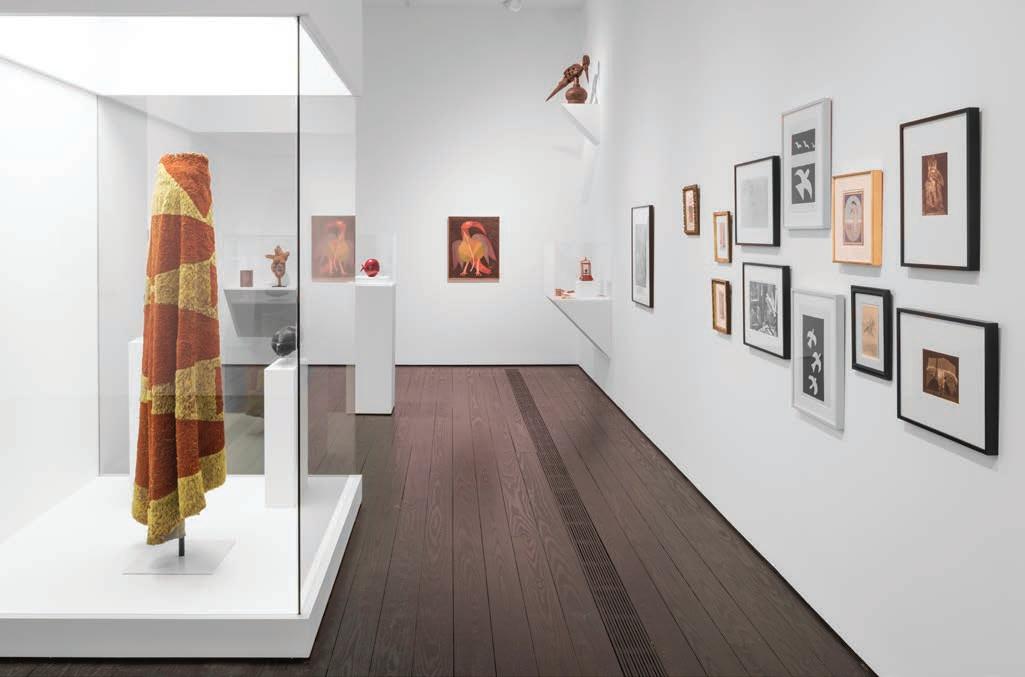

Allison Janae Hamilton, Scratching at the wrong side of firmament., from the series Sweet milk in the badlands, 2015. Inkjet print, 24 × 36 in. (61 × 91.4 cm). The Menil Collection, Houston, purchased in part with funds provided by Betty Moody and Kerry Inman. © Allison Janae Hamilton
Photography and the Surreal Imagination February 5–November 29, 2020
This exhibition presented the wide reach of the surreal imagination in modern and contemporary photography. Anchored in historical Surrealism, it explored photography’s central tension between documentation and invention, a generative force for artists connected to that movement. These artists produced images that teeter between truth and suggestion, reality and its invented double. Drawn from the Menil’s holdings and Houston collections, the exhibition demonstrates how this vision of photography continues to hold sway and how artists have used the camera to reshape, question, and disturb the way we see the world. The presentation began with an examination of the transformation of the everyday through the lens in a tradition that recasts the world as an enigmatic theater, from Eugène Atget’s shots of Old Paris to Allison Janae Hamilton’s haunted folklore of the American South. Photographs in the exhibition also foreground the exploration of the body, including Hans Bellmer’s images of deconstructed dolls and Cindy Sherman’s cinematographic self-staging, among other depictions of costumed, distorted, and fragmented figures. Lastly, the show considered the manipulation of the image. It highlighted artists from Man Ray to Lorna Simpson, all of whom turned the photographic surface into collision of pictorial fragments that questions the nature of representation. Photography and the Surreal Imagination was curated by Natalie Dupêcher, Assistant Curator of Modern Art, and coincided with the FotoFest Biennial 2020.
This exhibition was generously supported by the City of Houston.
Installation view of Photography and the Surreal Imagination. Photo: Paul Hester


Brice Marden, 15 × 15 12, 2015–17. Ink and colored ink on paper, 20 × 15 in. (50.8 × 38.1 cm). Collection of the artist. © 2021 Brice Marden/Artists Rights Society (ARS), New York
Think of Them as Spaces: Brice Marden’s Drawings February 21 – October 11, 2020
Think of Them as Spaces: Brice Marden’s Drawings explored the draftsmanship of Brice Marden (b. 1938) and the catalytic role the technique plays within his practice. In a 1979 written statement, Marden asked that his drawings be thought of “as spaces.” This comment suggests that for him, drawing not only exists in more than two dimensions, but also is capable of reflecting the spirit and experience of a particular place. As seen throughout his work, Marden’s expansive vision explores how landscape, architecture, and objects found in nature shape one’s way of understanding the world. This exhibition presented six discrete series of drawings that span nearly the entirety of Marden’s ongoing career, highlighting the processes of invention and permutation that occur as he works and thinks on paper. One series—composed of twelve drawings with dense layers of pigmentation—revisits geographies and methods crucial to his early work, namely the architectural forms of ancient Greece and the heavily worked and opaque surfaces of wax and graphite that first brought him to prominence. Additionally, the presentation mapped how the artist’s two watershed series, The Seasons and Cold Mountain, have reverberated within his practice and have evolved over decades. Drawing as a means of study, a quality that runs throughout his oeuvre, is particularly apparent in his examinations of proportion and ratio as well as in works taken from sketchbooks that Marden completed while traveling. Think of Them as Spaces: Brice Marden’s Drawings was organized by Kelly Montana, Assistant Curator at the Menil Drawing Institute.
Major funding for this exhibition was provided by Janie C. Lee and Schlumberger. Additional support came from Angela and William T. Cannady; Diane and Michael Cannon; Julie and John Cogan, Jr.; Carol and David Neuberger; Mathew and Ann Wolf Drawings Exhibition Fund; Eddie and Chinhui Allen; Clare Casademont and Michael Metz; Barbara and Michael Gamson; Diana and Russell Hawkins; Janet and Paul Hobby; Linda and George Kelly; Susan and Francois de Menil; Susanne and William E. Pritchard III; Leslie and Shannon Sasser; James William Stewart, Jr.; Taub Foundation/Marcy Taub Wessel; Nina and Michael Zilkha; and the City of Houston.

The Menil Society exhibition preview, February 20, 2020. Photo: Daniel Ortiz
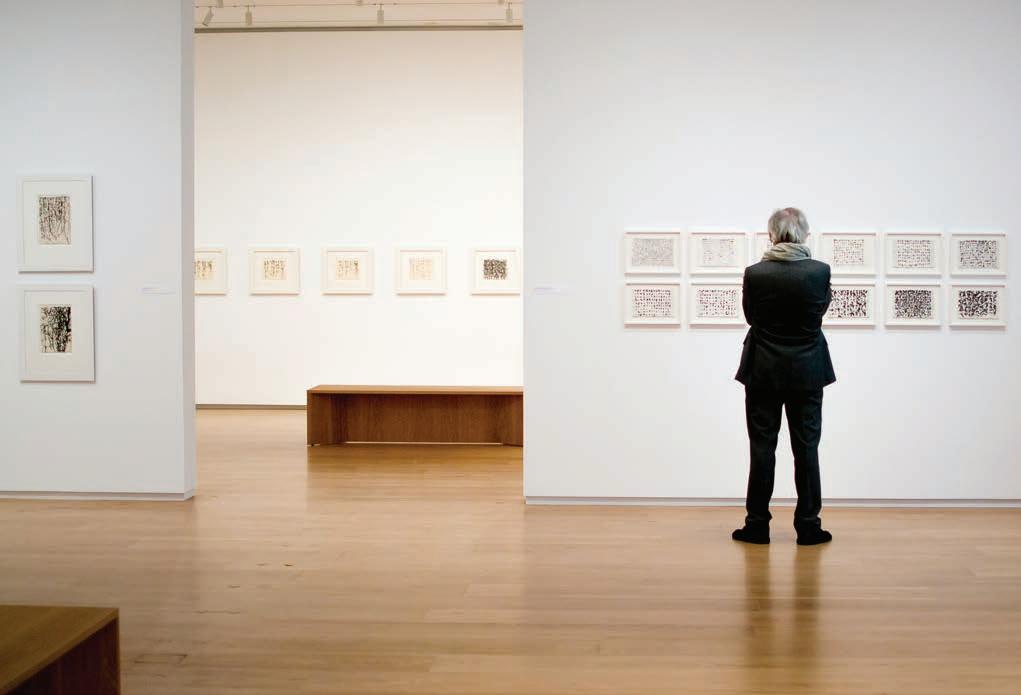

Jorinde Voigt works on Vertical at the Menil Drawing Institute. Photo: Adrian Porikys
Wall Drawing Series: Jorinde Voigt September 28, 2019–April 11, 2021
The Menil Collection commissioned Berlin-based artist Jorinde Voigt (b. 1977) to create the second in an ongoing series of wall drawings for the Menil Drawing Institute. Known primarily for her works on paper, Voigt’s precise methods of mark-making are influenced by musical scores, philosophic notional systems, and scientific diagrams with complex mapping structures. Vertical, 2019, begins with the concept of a “vertical axis,” a line that sits perpendicular to the earth and tracks the rotational movement of a body. This work responds to the vegetation and natural resources endemic to Houston and the Gulf Coast region, and records Voigt’s presence within this landscape. Using mark-making strategies evocative of artists like Joseph Beuys and Cy Twombly, Voigt’s drawing takes its substructure from sources as diverse as geologic mapping and the force of gravitational pull. With the composition unfolding on two opposite walls ten feet in height, this immersive piece was Voigt’s largest to date, and the first in which the artist employed chalk as the primary medium.
Major funding for Vertical, 2019, was provided by Scott and Judy Nyquist.
Installation view of Jorinde Voigt, Vertical, 2019. Photo: Paul Hester

During Fiscal Year 2020, the Menil loaned twenty-four objects to the following fifteen institutions in six countries:
CCS Bard Hessel Museum of Art, Annandale on Hudson, New York Centre for Fine Arts, Brussels, Belgium Houston Museum of African American Culture, Houston The Metropolitan Museum of Art, New York Modern Art Museum of Fort Worth Musée d’arts de Nantes Musée National d’Art Moderne, Centre Georges Pompidou, Paris Musée national Picasso Paris Musées Royaux des Beaux Arts de Belgique, Brussels, Belgium Museu d’Art Contemporani de Barcelona The Museum of Contemporary Art, Los Angeles The Museum of Fine Arts, Houston Palazzo Reale, Milan Pulitzer Arts Foundation, St. Louis Tate Modern, London
Installation view of Zarina: Atlas of Her World at the Pulitzer Arts Foundation in St. Louis, Missouri. September 6, 2019–February 16, 2020. Photo: Alise O’Brien © Pulitzer Arts Foundation and Alise O’Brien Photography
